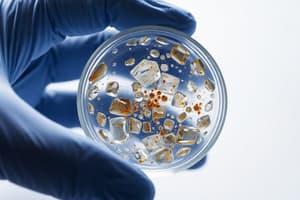Podcast
Questions and Answers
What is the correct procedure to begin observing soil samples under a stereomicroscope?
What is the correct procedure to begin observing soil samples under a stereomicroscope?
- Mix the soil sample with water before observation.
- Place the soil sample in a test tube.
- Place the slide/plate with the soil sample on the viewing stage of the stereomicroscope. (correct)
- Use a regular microscope instead of a stereomicroscope.
Which color of particles in soil indicates the presence of iron oxide?
Which color of particles in soil indicates the presence of iron oxide?
- Red particles (correct)
- Green particles
- Colorless particles
- Black particles
What does the presence of bubbles when adding hydrochloric acid to a soil sample indicate?
What does the presence of bubbles when adding hydrochloric acid to a soil sample indicate?
- Insoluble carbonates (correct)
- Presence of soluble iron
- Colorless quartz grains
- Dried vegetation particles
What is the primary purpose of conducting an ignition test on a soil sample?
What is the primary purpose of conducting an ignition test on a soil sample?
Which method is used to observe the acid-alkali behavior of soil?
Which method is used to observe the acid-alkali behavior of soil?
What is the significance of adding potassium ferrocyanide solution to the soil sample?
What is the significance of adding potassium ferrocyanide solution to the soil sample?
Which step is included in particle size distribution analysis of soil?
Which step is included in particle size distribution analysis of soil?
What type of particles may be observed as traces of foreign materials in the soil?
What type of particles may be observed as traces of foreign materials in the soil?
Which method is preferred to observe soil samples under a microscope?
Which method is preferred to observe soil samples under a microscope?
What should be done with soil samples before examination under a microscope?
What should be done with soil samples before examination under a microscope?
Which of the following is NOT a step in preparing soil samples for microscopic examination?
Which of the following is NOT a step in preparing soil samples for microscopic examination?
Why is it important to make a thin layer of soil on the slide for microscopy?
Why is it important to make a thin layer of soil on the slide for microscopy?
What should be avoided when preparing soil for microscopic examination?
What should be avoided when preparing soil for microscopic examination?
Which of the following equipment is used to view soil samples microscopically?
Which of the following equipment is used to view soil samples microscopically?
What can affect the visibility of soil components under a microscope?
What can affect the visibility of soil components under a microscope?
What is the first step in the microscopic examination of a soil sample?
What is the first step in the microscopic examination of a soil sample?
What observation indicates that the refractive index of a glass fragment is the same as that of the surrounding liquid?
What observation indicates that the refractive index of a glass fragment is the same as that of the surrounding liquid?
What does it mean if the Becke line appears inside the glass fragment?
What does it mean if the Becke line appears inside the glass fragment?
What is the main purpose of using the immersion method in refractive index study?
What is the main purpose of using the immersion method in refractive index study?
How is density calculated?
How is density calculated?
What apparatus is used to observe the disappearance of the Becke line when increasing temperature?
What apparatus is used to observe the disappearance of the Becke line when increasing temperature?
Which of the following liquids has the highest density?
Which of the following liquids has the highest density?
What indicates a successful physical matching of glass pieces collected from a crime scene?
What indicates a successful physical matching of glass pieces collected from a crime scene?
What is the significance of observing the Becke line under a microscope?
What is the significance of observing the Becke line under a microscope?
Flashcards
Soil Sample Collection
Soil Sample Collection
Systematic gathering of soil from a location of interest, often for forensic analysis.
Soil Sample Preservation
Soil Sample Preservation
Methods to maintain soil's integrity and prevent degradation in case of wet or dry soil
Soil Sample Packaging
Soil Sample Packaging
Proper container selection for soil samples to prevent contamination and damage.
Blood-stained Soil Treatment
Blood-stained Soil Treatment
Signup and view all the flashcards
Sodium Chloride (NaCl)
Sodium Chloride (NaCl)
Signup and view all the flashcards
Soil Sample Drying
Soil Sample Drying
Signup and view all the flashcards
Microscopic Soil Examination
Microscopic Soil Examination
Signup and view all the flashcards
Sample Labeling
Sample Labeling
Signup and view all the flashcards
Soil Particle Color
Soil Particle Color
Signup and view all the flashcards
What do bubbles in soil indicate?
What do bubbles in soil indicate?
Signup and view all the flashcards
What indicates soluble iron in soil?
What indicates soluble iron in soil?
Signup and view all the flashcards
Particle Size Distribution
Particle Size Distribution
Signup and view all the flashcards
What is the purpose of the ignition test?
What is the purpose of the ignition test?
Signup and view all the flashcards
What does pH measure in soil?
What does pH measure in soil?
Signup and view all the flashcards
What is the significance of pH variation with dilution?
What is the significance of pH variation with dilution?
Signup and view all the flashcards
Glass Fluorescence
Glass Fluorescence
Signup and view all the flashcards
Glass Thickness
Glass Thickness
Signup and view all the flashcards
Glass Refractive Index
Glass Refractive Index
Signup and view all the flashcards
Becke Line
Becke Line
Signup and view all the flashcards
Becke Line Inside Glass
Becke Line Inside Glass
Signup and view all the flashcards
Becke Line Outside Glass
Becke Line Outside Glass
Signup and view all the flashcards
Glass Density
Glass Density
Signup and view all the flashcards
Density Matching
Density Matching
Signup and view all the flashcards
Study Notes
Glass
- Glass is a hard, amorphous material made by melting sand, lime, and sodium oxide at high temperatures.
- Its atoms are randomly arranged.
- Main component is silicon dioxide (silica).
Characteristics of Glass
- Hard, amorphous solid
- Usually transparent
- Primarily composed of silica with oxides
- Brittle
- Exhibits conchoidal fracture
Types of Glass
- Soda-lime Glass: Most common (approx. 90%). Used in windows, containers, and light bulbs. Inexpensive to produce and can be reheated and recycled easily.
- Soda-lead Glass: Used in fine tableware and art objects. Higher density and refractive index than soda-lime, making it more brilliant.
- Borosilicate Glass: Heat-resistant, like Pyrex. Used for cooking and laboratory equipment. High resistance to temperature changes and chemicals.
- Silica/Fused Silica Glass: Used in chemical equipment and space shuttle windows. Strongest and most thermally stable.
- Tempered Glass: Used in car windows and phone screens. Stronger and safer than annealed glass; shatters into small, less sharp pieces when broken.
- Laminated Glass: Consists of two sheets of tempered glass bonded with PVB. Used in car windshields for safety and security.
- Colored/Tinted Glass: Tinted with metallic salts during manufacturing.
- Wire Mesh Glass: Glass with embedded metal wire. Helps hold broken pieces together.
Glass as Forensic Evidence
- Broken glass is important evidence.
- Different types have unique properties.
- Fragments can travel up to 9 feet.
- Can be found on clothing, shoes, or hair.
- Fracture patterns provide clues about the object and the angle of impact.
- Experts analyze the breakage to understand projectiles causing the break.
Handling of Crime Scene Glass
- Identify and photograph any glass samples.
- Collect largest fragments possible.
- Look for trace evidence (hair, fibers, blood).
- Package fragments carefully in boxes padded with cotton.
- Submit with a control sample of the type of glass from the crime scene.
Forensic Examination of Glass
- Compare glass samples' physical and chemical properties.
- Analyze optical properties (color, refractive index).
- Evaluate non-optical characteristics (surface wear, thickness, and density).
- Examine chemical properties (additives, trace elements).
- Goals are: -Identify glass types present. -Determine how the glass was fractured. -Individualize glass fragments to a source.
Physical Characteristics of Glass
- Color
- Thickness
- Fluorescence
- Patterns/Designs
- Markings (striations, dimples)
- Density
- Refractive index
Physical Matching of Glass
- Match larger fragments based on physical similarities.
- Counting fragments and how they fit together to determine source.
Refractive Index Study
- A measure of how glass bends light.
- Immersion method: Immerse a glass fragment in liquid with similar refractive index to see if invisible or a halo ("Becke line") appears
- Becke line: used to observe if the fragment's refractive index matches the liquid.
- Observation:
- No Becke Line: Fragment and Liquid have same refractive index.
- Becke Line inside glass: Fragment's refractive index is higher than the liquid.
- Becke Line outside glass: Fragment's refractive index is lower than the liquid.
- Hot stage: Increasing the temperature can get to the match point when the Becke line disappears
Density Study
- Measures of density (mass/volume) using displacement.
- Different types of liquids with varying densities
- Determine the glass type from its density.
- Direct method: Measuring of mass and volume using displacement method.
Fracture Study & Sequencing
- Fracture patterns are unique and help determine the origin, direction of force, and sequence of impacts.
- Radial fractures: originate on the opposite side of the force.
- Concentric fractures: originate on the same side as the force.
- Cone fractures: Caused by high-velocity projectiles, resulting in a crater-shaped hole surrounded by fractures.
Soil
- Soil is any disintegrated material on or near the earth (natural or manufactured).
- Soil has unique properties useful for forensic examination.
- Types of Soil
- Sediment
- Sandy Soil
- Silt Soil
- Clay Soil
- Loamy Soil
- Peaty Soil
Soil as Evidence
- Soil from a crime scene or related items can be compared to standard/reference samples for a comparison.
- Collected for comparison within a 100-yard radius of the crime scene, from similar environments.
Collection of Soil Samples
- Handling/Collection:
- Use appropriate tools (spatula, trowel) for sample collection and placement in containers.
- Remove the lids from containers to allow for gradual drying if necessary
- Containers (rigid, airtight, waterproof) for sample storage.
Preservation of Soil Samples
- Store samples immediately after collection, using refrigerated or dark, cool areas.
- Avoid freezing.
Microscopy Observations
- Examine soil particles visually under a stereomicroscope. -Examine under several magnification levels for more detail
- Examine particle color, shape, and size.
Chemical Reagent Observations
- Observe the reaction of the soil under chemical reagents for possible indication of substances.
- Confirm identification of observed substances using confirmatory reagents.
Particle Size Distribution of Soil
- Separate soil using a set of sieves to divide the soil samples by size.
- Measure the weight of each soil size for percentage analysis.
Ignition Test (Soil)
- Heat the sample to determine water content and weight loss.
- Compare the weight loss of a suspect soil sample with a known soil sample from a given area (comparison soil sample)
pH Measurement (Soil)
- pH is useful in determining soil acidity/alkalinity.
- Prepare a known soil sample in a liquid of controlled volume.
- Measure and compare the pH values of the soil samples to determine compatibility.
Studying That Suits You
Use AI to generate personalized quizzes and flashcards to suit your learning preferences.




